Epson Expression 11000 XL Pro detailed test report
In June 2013 Epson released with the Expression 11000 XL a successor for the long time proven Epson Expression 10000 XL on the market. It is a large format scannner, which can digitize originals up to a size of DIN A3 (approx. 40x30 cm). With the optionally available transparency unit films (positives or negatives) can be scanned also up to that size. Epson offers the Expression 11000 XL with the transparency unit as a bundle named Expression 11000 XL Pro.
When an Expression 10000 XL becomes an Expression 11000 XL, one expects a big progress, i.e. a new model with better qualities, new features and better equipment. However, that's not the case, on the contrary: The Epson Expression 11000 XL is almost identical to the Expression 10000 XL; from the outer appearance you cannot recognize any differences and the performance data are equal. At the Expression 11000 XL only a couple of interior parts were changed in order to correspond to the latest norms and environment requirements.
In the course of that change Epson has omitted the network interface and the connectability of the automatic document feeder at the Expression 11000 XL. Furthermore the Expression 10000 XL could be connected to the PC both via USB and via firewire interface. At the Expression 11000 XL there is only the USB interface. So with the Expression 11000 XL one gets less thatn with the Expression 10000 XL.
Equipment, accessories and performance data of the scanner
The Epson Expression 11000 XL is delivered in a large cardboard. This contains except the scanner everything you need in order to start scanning documents immediately: Connection cable, power cable, software and an installation manual in 7 languages. At the Epson Expression 11000 XL Pro there is also the transparency unit included in a separate cardboard so that you can digitize negatives and slides.
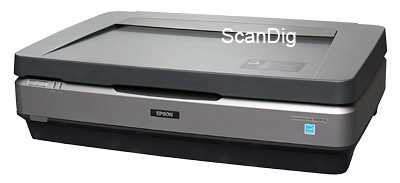
With a size of 65,6 x 45,8 x 18,5 cm and a weight of more than 15 kg the device needs a lot of space on a stable desk. In the contrary to most other flatbed scanners this scanner is set up in the landscape format, so the lid is not beeing opened at the small side of the scanner but on the long side. This construction provides more stability especially with the heavy transparency unit than the usual portrait format alignment.
For reflective scans the complete glass area of 31 x 43,7 cm is available. For scanning film material there is the optional transparency unit which can be put on the scanner instead the standard lid. This transparency unit offers a transparency area of 30,9 x 42 cm, so that you can digitze films up to A3 format.
In the delivery content of the transparency unit which is equipped with two lamps there are film holders for the most usual film formats. For the 35mm format there is a film holder for up to 15 framed slides and there is a film holder for up to 4 film strips, each with maximum 6 pictures. For scanning medium formatfilms there is a film holder for 3 roll film strips up to a length of 17,2 cm. And finally, the film holder for large format films can take 4 flat films of 4x5". All other film formats have to be put directly on the glass surface of the scanner in order to be processed.
The transparency guidance - a kind of ruler which is fixed at the edge of the scan area - makes sure for film scans that a fix narrow stripe at the edge of the scan area remains free from the originals. This strip is needed for the measurement of the transparency light before the scan. In the scope of the delivery of the transparency unit there is a lid which can be fixed in front of the light area so that one has a white background when scanning documents.
The Expression 11000XL is connected to the computer via USB 2.0 interface; a USB cable is included in the scope of delivery of the scanner. The predecessor also could be connected via IEEE 1394 firewire interface. The firewire interface has been omitted at the Expression 11000 XL compared to the predecessor.
The scanner has a maximum density of 3,8 and an optical resolution of 2400ppi. This is sufficient for document scans, and also large films can be scanned with this resolution. However, the thing is different at small film formats: A 35mm slide scan can be enlarged only up to 30x30 cm without quality loss. Which effective resolution the Expression 11000 XL achieves in practice, we will see in the chapter image quality.
A special feature of this scanner is the auto focus. In the contrary to most other flatbed scanners there is no fix focus level on the glass plate. If you scan mounted slides with thick frames you can focus exactly to the film level anyway so that you always get optimal sharpness. A scanner without adjustable focus would produce unsharp scans in such a situation.
Unfortunately this scanner is not equipped with a hardware based dust and scratch correction procedure like ICE, so that both reflective scans and transmissive scans have to be postprocessed afterwards in the image editing software. It is a pity that a scanner in this price area does not have this comfortable feature included.
For the profiling of the scanner with the optional scan software SilverFast Ai there are reflective and transmissive targets from Lasersoft Imaging available. With these you can calibrate the scanner simply and comfortably. More information about scanner calibration you can find on our detailed site about IT-8 colour calibration.
Installation and setup of the Epson Expression 11000 XL
The installation of the Epson Expression 11000 XL is quite simple: First you install the software - here you have the choice between the manufacturer's software EPSON-Scan and the excellent SilverFast Ai scan software from Lasersoft Imaging. During the installation of these two programs you just have to follow the instructions at the screen and then the software is ready for use.
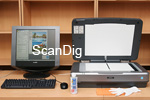
Now you just hav eto connect the scanner to the electric circuit and via USB 2.0 to the computer. The Expression 11000 XL has a clever transportation lock: In front of the power interface there is a slider which is pushed upwards automatically when connecting the power cord thus unlocking the transportation lock. In this way it is prevented that you forget unlocking that lock and the scanner gets damaged when beeing switched on.
At the transparency unit the transport lock has to be used manually. Here a noticeable yellow sticker makes sure that you don't forget it. Therefore you have to twist a skrew with a coin or something similar by 90° counter clockwise. The transparency unit is put on the scanner like the standard lid simply with stable bolts at the hinges. Then you connect both components via a serial interace at the options connectionl. If you switch on the scanner now it will be recognized immediately and you can start scanning.
The scanner is a huge thing on your desk. If you have a standard PC with screen and keyboard next to it, the PC seems to be very small compared to the Epson scanner. So you don't put that scanner somewhere on your desk additionally, much more you need a separate working desk in order to work finde with that scanner.
Scan software for the Epson Expression 11000 XL
Epson delivers the Expression 11000 XL with its own scan software EPSON-Scan. That is a simple scan software, with which you can scan both documents and films. As an alternative there is the professional scan software SilverFast Ai, with which you can calibrate the scanner and usually achieve much better image results.
Scanning with the EPSON-Scan software
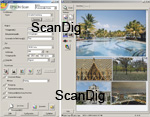
The EPSON Scan software offers three operation modes. The standard mode is configured for a as simple as possible handling. Here you have only restricted setting possibilities so that you cannot make wrong a lot. The office mode is, as the name already says, made for utilisation of the scanner in an office. In the professional mode you have the full control over all available parameters. Here you should know what you do. However, that does not mean, that the program is difficult to use in this mode. Everybode who knows the basics of scanning gets along with that mode very quickly.
EPSON Scan glints with a simple graphical user interface, and according to your choice and experience you choose the suitable scan mode. Since EPSON Scan is included in the standard delivery scope of the scanner you can start scanning immediately after the installation, thus digitizing documents and films easily.
As we will see later in the chapter image quality, EPSON Scan distinguishes itself by simplicity and clarity, however, unfortunately not by image quality. If you put importance to a high image quality you should use the SilverFast scan software which is described in the following chapter.
Scanning with the professional scan software SilverFast Ai
The scan software SilverFast Ai from the German manufacturer LaserSoft Imaging is a professional scan software which exists since a couple of decades for hundreds of scanner models. Many users buy the Epson Expression 11000 XL in a bundle with the SilverFast scan software just because they have learned using that scan software from other scanners. Since the graphical user interface and the operation is equal for all scanners, you heave to learn SilverFast only once and then you can operate any new scanner - a big time advantage at the training of a new scanner.
SilverFast Ai is a professional scan software, which offers countless setting possibilities in order to produces optimal scans. Whilst professional users appreciate the numerious setting possibilities and integrated filters, beginners appraise comfort functions like the job pilot which guides you step by step through the scan process. Not only by the fine adjustable setting capabilities but also by sophisticated image editing algorithms SilverFast Ai delivers a better image quality than other scan programs. Especially in the field of image editing algorithms you realize the experience of several decades of the software manufacturer Lasersoft Imaging. You can find detailed information about SilverFast on our site FAQ SilverFast.
The Epson Expression 11000 XL yields in combination with the SilverFast Ai scan software a significant increase in the image quality thanks to sophisticated image editing algorithms and numerous setting possibilities.
An absolute highlight of the profession scan software SilverFast Ai is the IT-8 colour calibration of the scanner. Thus you calibrate your scanner with the help of so called IT-8 targets. So you can compensate individual colour errors which each input device produces, and you can integrate the scanner into an ICC work flow of a colour management process, which is inevitable in the fields of art design and photography. But also the home user gets better image results at scanning when using colour management. Especially one can do without a lot of image editing work after scanning since the scans are much better after performing an IT-8 colour calibration. You can find detailed information about the IT 8 colour calibration on our website about scanner calibration.
Digitizing X-Rays with SilverFast X-Ray
A special application in the medical and scientific area is the digitizing of x-rays. Of course, on each flatbed scanner x-rays can be put on and scanned, however, usually one gets dissappointing results. Scanning x-rays requires high claims to the scanner and the scan software. With the Epson Expression 11000 XL one has a professional scanner which is suitable for scanning x-rays. From the German software manufacturer Lasersoft-Imaging there is a special scan software, which is made for scanning x-rays.
It is the scan software SilverFast X-Ray. It is a branch of the professional scan software SilverFast Ai which is described above. SilverFast X-Ray is similar to SilverFast Ai, i.e. if you kwow how to use the Ai version, you can handle SilverFast X-Ray without much training. The functions and settings are especially adapted to scanning x-rays; other functions do not appear in the function menu.
SilverFast X-Ray is built so that beginners can handle it quickly without much effort. This is important especially for doctor's offices and scientific institutes , where doctor's assistants or scientific assistants shall digitize an inventory of x-rays casually.
Advantages of the SilverFast Ai Studio version over the standard version
By default the Epson Expression 11000xl is delivered with the scan software SilverFast Ai Standard from the German software manufacturer Lasersoft Imaging. As a superior grade alternative there is the SilverFast Ai Studio version. This version contains all features of the standard version, and additionally has some features which provide better image results on the one hand side and make scanning more comfortably on the other side.
An essential additional function of the SilverFast Ai Studio version compared to the SilverFast Ai standard version is the Multi Exposure function. Thereby an original is scanned twice, once with dark exposure and once with bright exposure. From the resulting two scans an optimized image is calculated automatically, which shows a higher density range due to the multi exposure. Multi Exposure increases the image quality essentially. You can find detailed information about it on our SilverFast site about Multi-Exposure. Further down, in the chapter image quality you will see an example, what Multi Exposure can effect at the Epson Expression 11000 XL.
Another quality improvement of the SilverFast Ai Studio version brings the auto adaptive contrast optimization (AACO), which provides more details at high contrast pictures. No improvement in the image quality however a much more comfortable scanning brings the automatic frame recognition and frame alignment. The automatic frame recognition detects automatically several originals on the glas surface of the scanner, and the automatic frame alignment aligns them exactly even if the originals are put askew on the scanner glass surface. This function saves a lot of time at daily scanning and makes scanning significantly more comfortable.
SilverFast Ai Studio provides a significant increase in the image quality by the multi exposure function compared to the SilverFast Ai standard version. The automatic frame recognition and frame alignment makes scanning faster and more comfortable.
Scanning of documents with the Epson Expression 11000 XL
As A3-scanner the Epson Expression 11000 XL is capable to digitze large documents. But of course also smaller originals can be scanned without restrictions. In this case this scanner has the advantage that you can place more singular pictures on the glass surface.
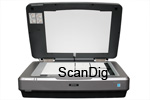
The procedure of scanning documents is known from other flat bed scanners. If you own the transparency unit, you have to cover the light area with the white lid before scanning. Then you fill the glass surface with documents, close the lid and make a prescan with the scan software. Then you select the scan area or the scan areas, respectively, with a frame within the software, make the desired settings and start the main scan.
A batch process for scanning several documents at the same time can both made with the EPSON-Scan software and with the SilverFast Ai scan software. Also both with Epson-Scan and with SilverFast Ai an automatic image recognition is applicable, so that you don't have to set a scanning frame for each singular picture to be scanned; the software does it automatically. That is very comfortable with the large scan area of the 11000 XL, since many small documents can be put on it.
The automatic image recognition within the EPSON Scan software does not work very well when documents are put askew on the glass surface, but is still a facilitation when scanning a larger amount of documents. The exact alignment can be done by yourself.
The Epson Expression 11000 XL is due to its size perfectly suitable for scanning documents and photos. You can fill the complete glass surface with pictures and scan them in the batch mode.
Scanning film material with the Epson Expression 11000 XL
With the optionally available transparency unit, which is already included in the Pro-model (Epson Expression 11000 XL Pro), the Epson Expression 11000 XL is perfectly suited for scanning film material. Thanks to its large scan area not only large formats can be scanned but also a big number of small formats can be digitized at a time.
When scanning transparent material you have to make sure that the small stripe at the beginning of the glass surface remains free, since it is needed for measuring the light before scanning. For this purpose a so called transparency guide is included in the scope of delivery of the transparency unit, which provides a fix edge at the same time and makes sure that the above described area remains free. It is important, that this field on the scanner is kept clean and free of dust, since dust particles can disturb the calibration process.
All film holders have the same size and have such a dimension that you can put two of them side by side on the glass surface of the scanner. The procedure of scanning does not differ from that which is known from other scanners. In the following we take a look at the different film formats.
Scanning mounted slides with the Epson Expression 11000 xl
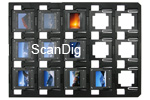
The film holder for mounted slides takes up to 15 slides. The frames are pushed down with the help of two springs at the side and are so fixed in their position. For an easy taking out the slides on the two sides of each slot there are gaps for the fingers so that you can take out a slide mount easily.
When using very thick slide mounts the springs make it a bit hard to put them into the slots. In the scope of our tests we could insert any type of frame, even if we had the feeling at very thick frames, that the thin plastic slots would not pass this kind of test very often. So it is better not to insert very thick glass frames into that film holder in order to minimize the risk of damaging it. In other respects you don't have to worry about the frame thickness thanks to the autofocus of the scanner.
With a capacity of 15 35mm slides the Epson 11000 XL beats any competitor which is only half as big. The increase from 12 to 15 slides, for example compared to the Epson Perfection V700 Photo, is not really big. However, if you buy a second slide mount holder you can two of them put on the glass surface, thus digitizing 30 35 mm slides at a time. Since the scanner does not have an automatic scratch and dust removal function you should clean your slides before scanning using compressed air by all means.
Scanning 35mm flim strips with the Epson Expression 11000 xl
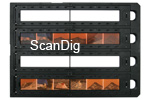
You can insert up to 4 film strips each containing maximum 6 pictures into the 35mm film strip holder. So you can scan up to 24 35mm pictures at a time. For doing this you open the cover for each film strip which fixes the film strip when beeing closed. In this way you can insert the film strips from above into the film strip holder, and you don't have to slide them in from the side, which might cause damages of the film material.
A simple base in the middle makes sure that the film strips don't hang down, thus avoiding unsharpness and deformations. It would be better, if there were 3 or even 5 bases in order to firm the negative strip better. There are better, more stable film strip holders on the market. Therefore, the Epson construction has the advantage, that you also can insert and scan 35mm panorama films. When scanning film strips with the Epson Expression 11000 XL you should wear cotton gloves by all means, since you take the risk when working with film strips, to touch their surface and scan your finger prints.
It also holds for the film strip holder as for the slide mount holder, that the capacity of 4 strips of 6 frames does not correspond to the size of the scanner. You can scan 24 35mm pictures on film strips with many other smaller flat bad scanners at a time. However, also for digitizing film strips you can buy a second film strip holder, thus putting two of them on the scanner surface and then double the amount of scannable pictures at a time.
Scanning medium format 120/220 film strips
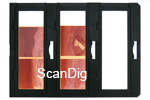
The film holder for medium format film strips can take three strips with a length of each max. 17,2 cm. So per strip there may be 3 images of the format 4,5x6 cm or two images of the formats 6x6 cm, 6x7 cm or 6x8 cm. With this film holder the Epson Expression 11000XL Pro scans more medium formats at a time than any other filmi scanner. Even if the medium format film holder seems to be very big and various, the length limit of 17,2 cm has one disadvantage: Many photographers have 3 6x6" pictures on one film strip and don't want to cut it. With a length of more than 18 cm, however, such a film strip does not fit into the 17,2 cm slot.
Like at the 35mm film strip holder also at the medium format film strip holder there is a flap mechanism per strip, and you can insert a film strip from above. So also here it is almost impossible to scratch a film strip. A fixing of curled or curved film strips,however, as it is possible, for example, at the medium format film scanner Nikon Super Coolscan 9000 ED, cannot be done with such a flap mechanism. When scanning medium format roll films it is also recommended to wear cotton gloves so that you don't touch the film surface inadvertently when loading or unloading the film strip holder .
If you want to digitize a larger amount of medium format films with the Epson Expression 11000XL Pro, you should think about buying a second or even third medium format film holder. So you can place two film holders on the glass surface of the scanner at the same time, and you can load another medium format film holder in quiet while the other one is inside the scanner beeing processed.
Scanning large format filmes with the Epson Expression 11000 xl
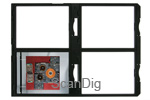
The DIN A3 scanner Epson Expression 11000XL is made for large format scans because of its large glass surface. You can insert up to four 4x5" films into the large format film holder. So the Epson Expression 11000XL beats any competitor in the DIN A4 scanner field. There is also a flap mechanism for the singular slots. For this film format a feature for straining the films would be desirable, yes even indispensable, since flat films tend to bend on one side. Such a feature, however, does not exist at hardly any flatbed scanner; it would make the construction very complex. In the face of the very high price for that scanner and the transparency unit Epson should think about it maybe for the future.
If you have to digitize larger amounts of 4x5" flat films you have made a good choice with the Epson Expression 11000 XL, even if the corresponding film holders are not the ideal construction for handling such film material. Unfortunately there are no other film holders for large format films. In order to scan larger films than 4x5" you have to put them directly on the glass surface and fix them with adhesive tapes. Of course this is time consuming, however, works pretty well.
Also for scanning large formats holdes: If you have to digitize a big amount of 4x5" flat films with the Epson Expression 11000XL, you should buy a second large format film holder. You can put two large format filmholders side by side on the glass surface of the scanner, so that you can scan 8 images in one batch job.
The image quality of the Epson Expression 11000 XL Pro
Like at all scanners also at the Epson Expression 11000 XL the image quality ist most decisive. In the face of the very high price for this device the expectations may be accordingly high. Ini this chapter we want to demonstrate, if the scanner cannot only digitize large formats but also do this in a good quality.
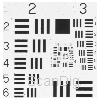
Let's start with the resolution of the scanner. Here a test with a USAF test chart shows, that the horiziontal lines of the element 5.3 and the vertical lines of the elemtn 5.4 are just recognizable. This yields an effective resolution of about 2170 ppi. At the first glance this seems to be few, however, it is really a good value considering the nominal resolution of 2400 ppi. Many scanners, which promise a nominal resolution of 7200 ppi, for example, don't achieve more than 2000 ppi in practice. At long last there is a device which fairly holds its promises.
For the digitalization of 35mm films the effective resolution of 2170 dpi is too small. Finally you receive image files with about 4-5 million pixels, which is rather the resolution of an average digital camera. Since there are image information of about 10 to 20 million pixels (depending on the quality, ISO value, camera and lense)in a 35mm film, this scanner only collects a part of the information contained in a 35mm film.
Of course also medium format films and large format films have much more information stored in the film than 2170 dpi. For the most applications in the medium and large format field, however, it is sufficient, if you make a scan with approx. 2000 dpi. Greater resolutions deliver extremely large, almost unmanageable image files. For the scanning of reflective material resolutions in the field of 300 to 600 ppi are sufficient; for this purpose the scanner is prepared best.
When assessing the image quality in terms of colours one has to distinguish between the EPSON Scan software and the professional SilverFast Ai scan software. EPSON Scan delivers scans of average quality which always have to be postprocessed in the image editing program. The colours usually don't match with the original colours; the scans are dull or wrongly exposed.
The results with SilverFast Ai are completely different: If you do an IT-8 colour calibration once before scanning you eliminate the colour errors of the scanner and produce true colour scans. The scans with SilverFast Ai show sufficient drawing in the lights and shadows, here other scanners, even some film scanners, don't show any details any more. Such a homogenous drawing of very bright and dark image areas are hardly achieved from any other flatbed scanner. Here the Epson 11000 XL does a very good job in combination with SilverFast Ai. The prerequisition is, of course, and this must be mentioned again, that the scanner is calibrated with an IT-8 target.
So this A3 scanner is indeed recommendable for scanning film material in contrast to many other flatbed scanners, if you don't need a very high resolution, for example, in order to make enlargements of 35mm films. At document scans the device also yields a very god image quality - the colours are brilliant and the full dynamic range of usual mediums can be catched completely.
Also the autofocus contributes to the good image quality, since also originals which don't lie perfectly flat on the glass surface, can be scanned with maximum sharpness. The auto focus can be activated or deactivated. If it is deactivated the focus area lies on the glass plate.
The only deficit in terms of image qulity is the missing ICE function. Dust and scratches can be removed or reduced only by the software, which often does not achieve acceptable results. So a time consuming, manual cleaning of the scans is inevitable. Many smaller, much more low priced flatbed scanners have a hardware based dust and scratch removal correction function integrated by default. This should be included in a scanner which costs several thousands Euros, too.
The Epson Expression 11000 XL yields average, usable scans in combination with the standard scan software EPSON scan. The image quality can be increased significantly with SilverFast and an IT-8 colour calibration.
As described above in the chapter scan software for the Epson Expression 11000 xl as an alternative for the SilverFast Ai standard scan software there is the SilverFast Ai Studio scan software. The studio version distinguishes itself mainly by the multi exposure feature. With this feature an original is scanned twice, once with a brighter and once with a darker exposure. From the two scans an optimized image will be computed automatically.
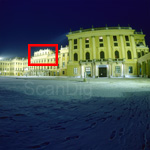
The adjacent image shows this effect at the example of a night shot. The image includes a very high contrast photography, from very dark image areas to very bright image parts. Many scanners reach their limits at such high contrast originals. When clicking on the thumbnail a new windows opens with the red area enlarged. The view changes between a scan without and a scan with multi exposure. The differences are fascinating: Whilst the building which is illuminated by bright light seems to be outshined at the scan without multi exposure, on the multi exposure scan you can recognize fine details at the facade.
Like at most scanners also at the Epson Expression 11000xl the multi exposure function provides a significant increase in the image quality at high contrast images. Multi-Exposure is included in the optional SilverFast Ai Studio version.
The small surcharge for the SilverFast Ai Studio scan software compared to the SilverFast Ai standard scan software is worth it just by the multi exposure feature. More information about multi exposure can be found on our SilverFast FAQ site.
Scanning speed of the Epson Expression 11000 XL Pro
In order to measure the scan speed of the Epson Expression 11000xl the scanner has been connected to a Core i3 Windows-PC with 6 GB memory via USB 2.0.
| Film format / resolution / mode |
Positive scan |
Negative scan |
| 35mm film 2400ppi colour |
1:09 min |
1:49 min |
| 35mm film 2400ppi grey tones |
- |
1:08 min |
| 6x7cm film 2400ppi colour |
2:03 min |
3:38 min |
| 6x7cm film 2400ppi grey tones |
- |
2:48 min |
| 4x5" film 2400ppi colour |
2:49 min |
4:01 min |
| Paper photo 10x15cm 300ppi colour |
0:11 min |
- |
| paper photo 10x15cm 600ppi colour |
0:41 min |
- |
| Paper photo DIN A4 (21x29,7cm) 300ppi colour |
0:17 min |
- |
| Paper photo DIN A4 (21x29,7cm) 600ppi colour |
1:21 min |
- |
| Paper photo DIN A3 (29,7x42cm) 300ppi colour |
0:29 min |
- |
| Paper photo DIN A3 (29,7x42cm) 600ppi colour |
2:42 min |
- |
The given scanning times are without focussing the scanner. For the focus process the Epson Expression 11000 XL needs approximately additional 45 seconds. The scanning times seem to be fast at the first glance. However, you can calculate, how long the scanner works, if you make several scans in the batch mode. For example, if you scan 15 35mm slides at a time, the scanner may work half an hour alone.
Summary, conclusion
The capability to digitize both reflective and transparent originals in the full A3-format (297 x 420 mm) distinguishes the Epson Expression 11000 XL from other flatbed scanners. The manufacture of the scanner makes a high value impression in the contrary to many other flatbed scanners. However, in the face of the very high price for the scanner, one can expect that.
The Epson Expression 11000 XL provides good results when scanning documents and paper photos. When scanning film material the image results are only average when scanning with the EPSON Scan-software and the image files have to be reworked in the image editing program. A significant improvement of the image quality can be achieved by using the SilverFast Ai scan software with IT-8 colour calibration.
The Expression 11000 XL is one of the few flatbed scanners which we recommend not only for scanning documents but also for scanning film material, however, only for medium format and large format films. Its large scan area makes the automatic process of many originals in batch mode possible. Only the relatively low resolution and the missing ICE function restrict its application in this area a bit.
Back to film scanner tests index
|